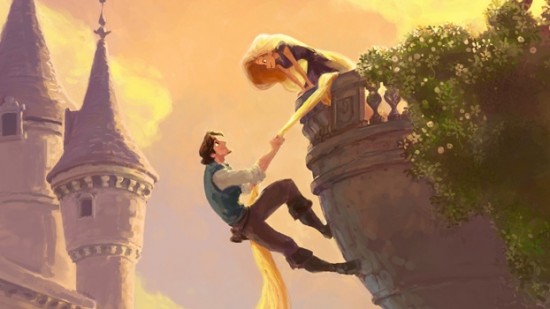
(Photo credits: via www.reviewstl.com, Disney's Concept art for Rapunzel.)
Oh, to be named after a food. In the story of Rapunzel, a woman longs for some lettuce, or some type of vegetable, from a garden that came be seen out her window. In the Grimm Brothers’ versions (there are two) of this story, the garden is owned by a witch. The woman’s husband sneaks into the garden and takes some of the vegetable that his wife is craving. In most versions of the story he is successful at first, but in a later attempt he is caught in the act by the witch. In Giambattista Basile’s The Pentamerone (a.k.a. The Story of Stories), Basile includes a story called Petrosinella. In his version the woman goes herself into the garden and the witch is actually an ogress. In “The Fair Angiola,” another Italian fairytale, seven women sneak into the garden, but only one is captured by the witch.
In each version, the owner of the garden demands the thief’s unborn child. The intruder is released, and after the child is born the witch/ogress comes to collect. Some versions say that the baby is traded right away, in other versions as much as seven years pass before the daughter is handed over to the witch. In most cases, the daughter is named for the food from the garden which the mother was craving. (Rapunzel is German for a type of lettuce; Petrosinella is Italian name meaning parsley.) The girl is taken by her capture and placed into a tower without doors or stairs. The only way in is through a window at the top. Each day when the witch comes, so that she can climb up, she calls for Rapunzel to let down her hair.
A prince eventually comes along and discovers the tower containing Rapunzel. In the Grimm’s versions the prince hears Rapunzel singing and is captivated. In other versions the prince sees her in the tower. After troubling over a way into the tower the prince eventually sees the witch come and call for Repunzel to send down her long hair. When the witch leaves the prince mimics the witch’s call and Rapunzel complies. When the prince comes through the window Rapunzel is shocked, but she quickly recovers. In the Grimm Brothers’ first edition of the story, included in their 1812 release, the prince comes back daily. Eventually Rapunzel gets pregnant and the witch discovers what has been going on. In the 1857 release of the story the Grimm Brothers change the story so that rather than getting pregnant, Rapunzel merely slips up and accidently mentions the prince to the witch. The witch cuts off Rapunzel’s hair and sends her away into the wilderness. When the prince returns, the witch lets down Rapunzel’s hair. The prince reaches the top and finds the witch. She tells him that he’ll never see Rapunzel again, and in distress he falls from the tower. He somehow lives, but the fall has made him blind. These versions of the tale are resolved by the prince wandering blindly for years until he comes to the wilderness where Rapunzel has been living. When she sees him she runs to him, hugs him, and cries. Her tears fall on his eyes, and his sight returns.
In other versions, as in the tale of “The Fair Angiola,” the prince proposes marriage when they first meet. Angiola (the Rapunzel character) agrees, and, after stealing three magical balls of yarn from the witch’s things, Angiola and the prince make their escape that very night. In “Petrosinella,” Parsley is trapped in the tower by magic and is unable to run away with the prince. The two lovers continue to meet until Parsley overhears the way to break the enchantment. She takes the three gallnuts that are the key to her freedom and runs away with the prince. The escape is discovered by the witch/ogress in both tales. The captor chases the couple and is about the catch up with them. But Angiola/Parsley uses the witch’s/ogress’ magic against her. In each story the girl throws down the magical balls one by one. In Parsley’s story, the first gallnut produces a bulldog, the second a lion, and the third a wolf. The wolf eats the ogress and the prince and princess are married. When Angiola throws down the balls of yarn, the first one creates a mountain of soap, the second a mountain of various sized nails, and the third a rushing river. Thwarted by the river, the witch curses Angiola with the face of a dog and returns home. The prince, believing that his parents would never let him marry Angiola as long as she was under the curse, hides her away in a cabin (basically he thinks his parent won’t let him marry someone so ugly.) Distraught, Angiola cries to her pet dog that came with her when she left the witch’s tower. The dog then goes to the witch and begs her to remove the curse. She eventually capitulates and Angiola is made even more beautiful than she was before. The prince sees that she is beautiful again and takes her to the king and queen who “were so pleased with her beauty that they welcomed her.”
Check out the stories for yourself:
The Grimm Brothers' "Rapunzel"(1857)
A comparison of the Grimm Brothers' First and Final Editions of Rapunzel
Thomas Frederick Crane's "The Fair Angiola"
Giambattista Basile's "Petrosinella," from The Pentamerone
Zipes, J. (2000). The Oxford companion to fairy tales: The western fairy tale tradition from medieval to modern. New York; Oxford University Press.
Warner, M.(1994). From the beast to the blonde: On fairy tales and their tellers. New York; Farrar, Straus and Giroux.
Ashliman, D. (2010). Grimm brothers’ home page. Retrieved from http://www.pitt.edu.
Heiner H. (1999). SurLaLune fairy tales. Retrieved from www.surlalunefairytales.com.

